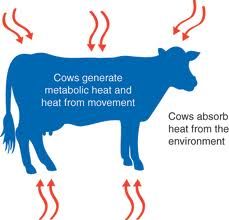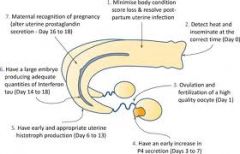![]()
![]()
![]()
Use LEFT and RIGHT arrow keys to navigate between flashcards;
Use UP and DOWN arrow keys to flip the card;
H to show hint;
A reads text to speech;
23 Cards in this Set
- Front
- Back
|
Which factors are associated with a decline in fertility in high producing dairy cows?
|
– Decrease in conception rates
– Increase in the number of services per conception – Increase in calving to conception intervals – Increase in interval from calving to first ovulation – Decrease in the duration of standing oestrus – Increase in use of American Holstein genetics (“Holsteinisation”) Fertility and oestrus duration of maiden heifers reains unchanged! |
|
|
What are possible causes for declining fertility in dairy cows?
|
• Likely to be multifactorial and complex
• As pregnancy rates in heifers are unaffected it suggests that changes that occur following calving (changes in diet, nutrition, energy demands) are having a negative effect on fertility. • Increase in dry matter intake and increase in metabolic rate, increases blood flow to liver, increases clearance rates of hormones such as P4 and E2. Results in a decrease in circulating concentrations of these hormones. • Increase in negative energy balance • Increase in concentrate feeding • Higher prevalence of anoestrous cows and longer postpartum to first ovulation intervals |
|
|
What cahnges in reproductive function are associates with deling fertility in dairy cows?
|
• Reduced oocyte viability
• Reduction in fertilisation rates • Less favourable uterine environment for early embryonic development (Walsh et al., 2011) • Lower concentrations of some reproductive hormones eg P4 – Lower concentrations of P4 before Day 7 of the oestrous cycle following ovulation and fertilisation can reduce embryo size and decrease pregnancy rates. This is thought to be related to less endometrial secretions (histotroph) • Reduced embryonic growth rates • Increase in early embryonic loss • Placental insufficiency • Increase in interoestrus intervals, delayed return to oestrus after AI of some cows (“phantom cows”) |
|
|
What are consequences of a less favourable uterine environment?
|
• Fewer embryos reach the uterus following ovulation
• Fewer embryos develop normally • Increased failure of maternal recognition of pregnancy – smaller embryos may produce less interferon-tau • Increased embryonic mortality |
|
|
How can gentics be used to reduce decline in fertiliy in dairy cows?
|
Genetics
– include an EBV for fertility and apply selection pressure. – Likely to be beneficial but progress will be slow as heritability is low – Cross breeding – Can help in some circumstances but may reduce milk yield |
|
|
How can nutrition be used to reduce decline in fertiliy in dairy cows?
|
• Reduce the depth and duration of negative energy balance
• Optimise BCS at calving and reduce BCS loss during lactation • Feed high quality forages, particularly in early lactation & gradually increase amount of concentrates rather than suddenly increase amount of concentrates • Maximise dry matter intakes – manage diet and environment so that there is minimal disturbance to cows eg established hierarchy, optimal welfare, health, diet composition • Composition of diet: research being undertaken into use of certain fats to increase energy content of diet and certain ingredients that yield glucogenic substances (glucose is liberated and absorbed in the small intestine) • Transition period: optimal well balanced diet |
|
|
How can heat detection be used to reduce decline in fertiliy in dairy cows?
|
– Optimise heat detection practices
– Consider fixed-time insemination strategies in some environments to bypass heat detection |
|
|
How can health and welfare reduce decline in fertiliy in dairy cows?
|
– Optimise animal health & welfare to enable optimum dry matter intake and reduce stress
– Reduce incidence of dystocia – Reduce incidence of lameness and manage lame cows – Hygienic calving practices – Manage uterine infections – Optimise neonatal health to reduce post natal losses |
|
|
What are effects of heat stress on reproductive performance?
|
• Thermoneutral zone for cattle is
between 23 and 27 oC • As temperature and humidity increase, the ability of cows to offload excess heat (radiation, conduction, convection) decreases • Internal core temperature will rise and have an adverse effect on physiological processes, rumen function and a detrimental effect on oocyte quality and embryo viability • Dairy cows are at greater risk due to their high internal heat production associated with the increased metabolic rate associated with high feed intakes and milk production |
|

What happens when cows get hot?
|

|
|
|
How does heat loss occur below and above the cows BT?
|
•Heat loss occurs by conduction, convection, radiation and
evaporation. •Once air temperature exceeds the cows body temperature heat loss can only occur by evaporation |
|
|
What are some consequences of heat stress on cattle?
|
• Reduced fertility particularly when heat stress occurs -1 to 6 days POST service but also in the weeks leading up to service (WEEKS -1 to -5)
• Reduction in the duration and intensity of oestrus • Reduction in semen quality in bulls • Reduced feed intake and nutrition • Reduced milk production and milk quality • Negative impact on cow health, rumen function |
|
|
What are specific impacts of heat stress on fertility?
|
– ↓6-week/100 day in-calf rates decreased
– ↑Not-in-calf rates increased – ↓Length and intensity of heats decreased – ↓ Conception rates decreased – ↑ Risk of embryo death increased – ↓Calf birth weight and viability reduced |
|
|
What are specific impacts of heat stress on feed intake & nutrition?
|
• ↑20-30% more maintenance energy needed to compensate for
the effort of keeping cool • ↓ Dry matter intake drops by 10-20% – short term or long term depending on the length and duration of heat stress • ↓Rumination and cud chewing decreases • ↓Cow’s ability to digest and absorb nutrients in feed decreased |
|
|
What are specific impacts of heat stress on milk production & quality?
|
• ↓ Milk production drop by 10-25% or more in high heat stress
and by 40% in extreme circumstances Milk composition is affected with high to severe heat stress: – Milk protein percentage decreased by 0.2-0.4% – Milk fat percentage is more variable day to day, and may be severely depressed if ruminal acidosis occurs • ↑ Sediment may increase if cows’ teats are allowed to be contaminated with mud and dung • ↑Risk of udder infection increased, which, if occurs, results in increased somatic cell counts |
|
|
What are specific impacts of heat stress on cow health?
|
↓ Rumen buffering capacity decreased
↓Decrease in rumen pH ↑ Risk of ruminal acidosis and ketosis increased ↑Risk of laminitis increased ↓Immune function suppressed ↑ Risk of mastitis increased |
|
|
What are reproductive consequences of heat stress?
|
• Reduced oocyte competence
• Reduced developmental competence of embryos – Retarded embryo development – Increased embryonic loss – Embryos are at greatest risk to heat stress 24 h after oestrus • Reduced production of interferon-τ • Reduction in steroidogenesis and decrease in hormone production • Compromised placental function in 3rd trimester probably due to a reduction in placental blood flow. – Reduction in calf birthweight & viability • Male: Reduced semen quality Times of highest risk • DAY OF SERVICE TO DAYS AFTER SERVICE (Days -1 to 6) • High heat load in weeks -1 to -5 of service also can detrimentally influence pregnancy rates |
|
|
How could you minimise negative consequences of heat stress on fertility?
|
• Cooling of cows – housing design, fans, provision of shade, sprinklers
(cows must be wet to the skin to be effective), provision of cool drinking water, delay afternoon milking to 5 pm, reduce distance cows have to walk for milking • Optimise nutrition to compensate for reduced dry matter intake during summer, provide adequate buffers, use high quality forages • Increase effort put into heat detection • Use AI to reduce infertility associated with heat stressed bulls • Use cheaper semen when heat stress is likely during breeding as pregnancy rates will be lower • Breed more heifers during hot months (less prone to heat stress) to help compensate for lower pregnancy rates in mature cows as pregnancy rates will be greater in heifers • Genetic improvement - Use tropically adapted, thermotolerant breeds • ET – transfer embryos collected in cooler months • Use fixed-time AI strategies where heat detection is a problem ± run bulls |
|
|
How does nutrition affect reproduction?
|
• Undernutrition delays the onset of puberty in heifers
• Pregnancy rates of heifers increase by about 21% from the first pubertal oestrus to the 3rd oestrus post puberty. Thus early onset of puberty can increase the percentage of heifers cycling at the start of mating and increase conception rate associated with the first oestrus after the start of mating. • Bodyweight is a useful guide to selecting heifers that are likely to be cycling at the start of mating. • Undernutrition can delay the onset of first ovulation post calving in cows and have a detrimental effect on pregnancy rates. |
|
|
Name the reproductive consequences of severe negative energy balance
|
• Increased days to first ovulation (increased duration of
postpartum anoestrous) • Decreased secretion of LH • Decreased concentrations of IGF-I • IGF-I increases the effects of LH on ovary • Lower IGF-I reduces the effectiveness of LH • Delayed uterine involution • Decreased conception rates • Increased embryonic loss • Potential for later calving and shorter calving to breeding intervals in following year |
|
|
Which mineral/trace elemamts are ofthen implicated in reduced reproductive performance?
|
• P
• Se/Vitamin E – Reduced conception rates can occur in Se deficient areas • Iodine • Cu, Mn, Co deficiency - reduced reproductive performance in some studies • Vitamin A • Zn |
|
|
How do minerl/trace element deficiencies potentially affest reproduction and what are possible maifestations?
|
Potential effects:
• decreased activity of rumen microorganisms and decreased digestibility • Altered enzymatic action, which alters energy or protein metabolism or hormone synthesis • Reduced integrity of reproductive cells, anti-oxidant effects Manifest as: • Reduced conception rates • Prolonged postpartum anoestrous intervals • Reduced dry matter intake or digestibility • Increase in embryonic loss rates or abortion • Retained placenta |
|
|
Whate are the most important factors affecting theestablishment of pregnancy in dairy cows?
|

|

